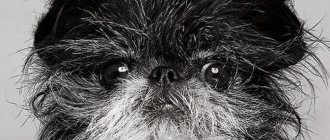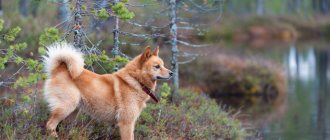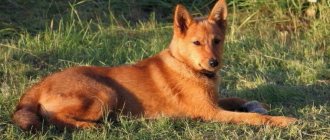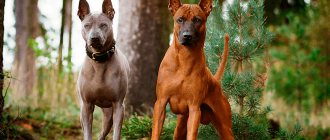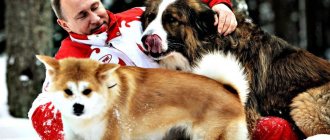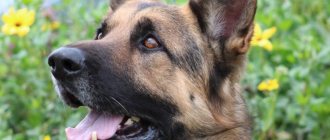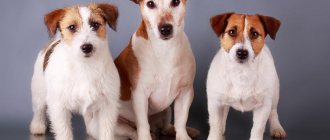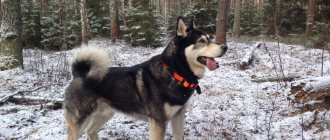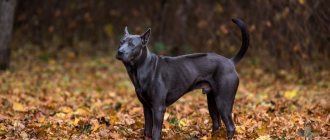The dog belongs to the class of mammals, the canine family. It is one of the first living creatures domesticated by humans. Today, dogs, along with cats, are the most popular type of pet in most countries of the world. The theme of the relationship between man and dog has become the plot of many famous works of art and literature.
Origin of dogs
Information about the evolution of the genus is very contradictory. There are two versions about the origin of these dogs. According to the first, their ancestor was a wolf, the second calls the dog a descendant of a jackal. It is also possible that both of these animals could be the ancestors of different breeds of dogs. The famous biologist Carl Linnaeus argued that dogs, like the jackal, wolf and coyote, descend from a common, long-extinct ancestor. Also popular is the theory of interspecific crossings of the above-mentioned species, as a result of which canines appeared.
When I became home
As you know, the dog was domesticated by people before most other animals. According to archaeologists and zoologists, this most likely happened during the Upper Paleolithic on the territory of modern Eurasia, about 40 thousand years ago, but this information is considered controversial.
The first report of a dog occurs in the historical period - 12 thousand years BC. The first domesticated animals were used by humans as guards for homes, and later they began to be used as hunting assistants - this is evidenced by rock paintings depicting hunts for game with the participation of dogs.
Fighting dog breeds
They were bred by selection of physical characteristics and aggressive character. They require special attention in maintenance and training. Fighting breeds include the American bully, Dogo Argentino, and pit bull.
Tosa Inu
A large breed of Japanese origin, weighing up to 90 kg. Dogs do not require a command to attack an enemy; they make the decision on their own. They practically feel no pain. European Tosa Inus have a developed protective instinct. In Japanese dogs, fighting qualities come first.
Appearance
Thanks to the efforts of breeders and breeders, the appearance of modern canines varies greatly depending on the breed. The sizes are small, medium, large and even giant.
The following characteristics remain the same:
- the animal has an elongated body;
- moves on four legs that are almost symmetrical in size;
- its head consists of a skull and muzzle;
- most varieties have tails of varying lengths and shapes.
The ears of the animal are erect, hanging and semi-erect. The jaw may have a scissor bite or an undershot bite, where the lower jaw protrudes forward. The coat can be short, long, curly and curly. Even a bald, completely naked dog was bred.
Hypoallergenic dog breeds
Suitable for allergy sufferers who want to make a friend. There is no shedding or very little hair falls out. The hair is smooth and short in length. Most often these are small breeds of dogs, but there are also large specimens.
Giant Schnauzer
The male is able to grow up to 70 cm. The wool is medium length, black or dark gray. Proportionally developed body with cropped ears. The dog has a loyal character and is ready to do the work of a watchman. The tendency to aggression is extinguished by active pastime.
Based on size, dogs are divided into small, medium and large.
Internal structure
The skeleton of this mammal includes six lumbar vertebrae, as well as a varying number of vertebrae in the tail. The jaws include 42 teeth, 4 of which are sharp fangs, the front 3 are incisors, the rest are used for gnawing and grinding meat and other food. The animal's sweat glands are located on the nose and paw pads.
The animal's heart is slightly shifted to the left, as a result of which the left lung is developed slightly less than the right. The canine intestines are up to seven meters long. A small dog breathes about 20-23 times per minute, a larger dog - 12-15 times. A dog's normal pulse ranges from 70 to 110 beats per minute - the smaller the animal, the faster the pulse.
Leather and wool
Dog skin protects against injury, infection and temperature changes. It consists of 2 layers:
- outdoor
(epidermis), covered with hair and antibacterial fatty lubricant;
- main
(dermis), hiding all blood vessels, nerve tissue and glands.
Thanks to a special protective layer, the skin of four-legged pets does not need to be treated with an antiseptic before the injection. But it is important to clarify that the fat layer is washed off with frequent bathing. That is why it is recommended to bathe the dog only if it is heavily soiled.
The length and color of the coat depend on the breed. Dog hair follicles are very sensitive, so during a fright, a characteristic stripe of raised hairs appears along the line of the spinal column.
Sense organs
Of all the senses, dogs have the best developed sense of smell. The nasal mucosa is covered with nerve endings that are responsible for recognizing many different, sometimes subtle odors. Some individuals are able to smell game hundreds of meters away. They can also remember smells, for example, so they can track prey later.
In second place in terms of sensitivity is hearing. The dog distinguishes sounds in the range of 45,000 Hz and does not lose hearing even if the eardrum is damaged. Things are much worse with vision. An adult is able to distinguish objects only at a distance of 40 meters. At the same time, puppies see better than their older brothers.
Facts about dogs
Dogs have developed intelligence and know how to communicate, not only with each other, but also with people, they understand us (but not all of them and not always). They are social animals, capable of experiencing complex emotions and feelings, and being able to express them.
Surprisingly, dogs are able to determine the emotions and feelings of people with just one glance. They instantly assess the situation and behave accordingly, and their behavior depends on the feelings they have for this person. It’s interesting that they can smile and laugh (it sounds like x-x).
Dogs have one of the most developed senses of smell in the world, they smell a hundred thousand times better than people. They also have excellent hearing and are able to distinguish ultrasound. By the way, it is thanks to these characteristics that animals can predict the weather and sense the approach of natural disasters.
But dogs cannot boast of acute vision; on the contrary, their vision is very poor. Moreover, they do not distinguish colors at all and are color blind. You can also remember that during the first month puppies are blind; they receive information about the world thanks to their developed sense of touch.
Classification
Today, only one species of the genus has survived - lupus familiaris, i.e. homemade. A small exception is the second wild Australian Dingo and hybrids with wolves, called wolf-dogs.
The natural classification of rocks distinguishes only 9 classes.
Gundogs: setters, spaniels, pointers.
Hounds following the trail.
Greyhounds chasing game.
Herding Shepherd Dogs: Puli, Bobtail.
Watchdogs with a developed protective instinct.
Terriers specialized in detecting and chasing burrowing animals.
Fighting dogs, bred for fighting, whose genetic aggressiveness is now being combated by breeders.
Harness: husky, husky.
Decorative, initially considered exclusively as pets, as a rule, these are very unusual, beautiful dogs of small size.
Now many of these classes are losing their original meaning, turning into pets whose only task is to be a companion and companion to their owner.
Role in a person's life
Dogs are animals that play a big role in people's lives. Besides the fact that they simply live next to us and make our lives brighter and more varied, they also have many useful functions:
- Assistant dogs. These are animals that have been specially trained to help people with physical disabilities. An example is guides.
- Hunters. A large number of dogs with different habits have been bred for hunting. Some are designed for catching birds, others for hunting various animals.
- Service. They help police catch criminals and detect drugs and dangerous substances.
- Rescuers. Many human lives have been saved by these animals in the mountains during avalanches and from buildings destroyed by natural disasters.
Whatever the pet is, it always gives its owner selfless love.
Prevalence
Over centuries of close contact with humans, representatives of the canine family have become widespread in almost all corners of the globe. They live wherever there is a person. The animal's body is able to adapt to almost any climate. Only in Antarctica have man's best friends been banned since 1994, although theoretically they are able to withstand the low temperatures of this continent.
The structure and location of the internal organs of a dog
It is equally important to consider what the dog’s internal organs are made of. Despite their different functions, they are all interconnected. For this reason, a violation in one of the organs quickly affects the performance of others.
The brain is the head of everything!
The nervous system is divided into central and peripheral. The first includes both types of brain - the head and the spinal cord, and the second - the nerve fibers that entangle the rest of the body.
All animal actions are controlled by signals traveling along nerve trunks to the brain and back to the organs. Thanks to these impulses, not only conscious actions are carried out, but also unconditioned reflexes: breathing and swallowing.
Despite the complexity of this process and the very fast speed of information transfer (approximately 60 m/s), the dog's brain is quite small. The exact weight depends on the breed and is 45-100 g (for comparison, a human brain weighs from 1 to 2 kg!). But don't consider your pet stupid. Mental activity does not depend on the volume of the brain, but on the number of convolutions.
It is worth noting that four-legged pets are much inferior to cats in short-term memory. They remember their “stash” for no more than 5 minutes. That is why these pranksters often search the entire backyard in an attempt to find a bone hidden there in the morning.
The way to a dog's heart... is the digestive tract!
The digestion process begins even before food enters the pharynx. Its first stage is active salivation. The dog begins to salivate even when he simply sees his favorite treat or smells it. Thanks to salivation, hard pieces of food soften and pass freely into the esophagus without injuring the mucous membranes or getting stuck in one giant lump along the way.
From the esophagus, the mass moves into the stomach, filled with hydrochloric acid. This takes her about 30-60 minutes. Digestion takes much longer - 6-8 hours.
The digested mass moves to the intestines, where all elements beneficial to the body are drawn out of it. Unprocessed residues are compacted and enter the large intestine. Through it they come out in the form of feces.
Dog blowhole
The canine respiratory system is based on the gas exchange of oxygen and carbon dioxide. The air entering through the nostrils is thoroughly cleaned of dust and germs. It is carried out by special villi and viscous mucus, which traps all suspicious inclusions.
The air heated in the nasopharynx enters the larynx and trachea. From these, it enters the lower part of the respiratory system, consisting of the lungs and bronchi. From here, oxygen is transferred to the bloodstream, carried to all internal organs, and excess accumulated carbon dioxide is removed.
The breathing rate of four-legged pets ranges from 14 to 30 times per minute. It depends on temperature, physical activity, gender and breed of animal. Small dogs breathe most often, as their metabolic processes proceed at an accelerated pace.
The heart is a pump, the vessels are tubules
The most important muscle in the body is the heart. Thanks to the constant contraction of this organ, the circulatory system works. The left lobe of the heart is responsible for the movement of arterial blood saturated with oxygen, and the right lobe is responsible for the movement of venous blood containing carbon dioxide.
In addition to arteries and veins, blood vessels include tiny capillaries that surround all internal organs. It is through them that nutrients reach the desired destination.
Despite as many as 11 blood groups, four-legged pets do not have a Rh factor. When transfusion occurs, their breed is not taken into account. The blood type of a purebred dog and an ordinary mongrel may be the same.
Intimate matters
The appearance of the reproductive organs depends on gender. In males, sex hormones mature in the testes, and in females - in the ovaries. After maturation, sperm enter the penis from the prostate gland. During mating, they pass through the female's vulva into the vagina and meet the eggs. After fertilization, the cell is fixed in the uterus, where future puppies develop.
Please note that pregnancy is only possible after puberty. In males it occurs closer to 1 year, and in females it occurs during the third estrus. Mating too early can result in the death of the puppies or their mother.
The reproductive system is closely related to the urinary system. Urine is formed in the kidneys by cleansing the blood of waste products and toxins. It accumulates in the bladder and comes out through the urethra, located in the penis or vulva.
Lifestyle
Unlike their ancestors (the jackal and the wolf), canines have become accustomed to a daily lifestyle in accordance with the biorhythms of people. Most breeds need activity and long walks in the fresh air. Most dogs are playful, energetic and friendly creatures that suffer from lack of attention. The social organization of these animals is a pack, where each member has its own place in the hierarchy, and is headed by a leader. It is as a leader that a dog most often perceives its owner with proper upbringing. The owner's family for such a pet is analogous to a pack, with a leader who needs to be obeyed and younger members who need protection.
Behavior
Dog psychology was formed under the influence of close communication with humans, therefore this animal is able to understand its owner like no other - it has a rare level of empathy, is able to follow a human gaze in order to understand what they want from it.
Dogs have personality, character and temperament. They easily enter into communication both with their own kind and with other living beings, trying to trace their behavior, guess their aspirations and desires.
Dogs are curious and love to learn new things, which is why they are easy to train. They have a well-developed emotional memory, so they remember for a long time both a good attitude and aggression applied to them. The dog becomes very attached to its owner, tries to be around as often as possible and may not survive his death.
Nutrition
The described mammal belongs to carnivores; most of its diet is meat. The animal's body accepts beef best. The bird is given only when it is removed from the bones, which can injure the esophagus. Pork and fatty lamb are not recommended. The pet also needs vegetables, dairy products and grains. For healthy growth, babies are also given chicken eggs along with powdered shells rich in calcium.
In the modern world, owners most often feed their four-legged pets with industrially produced food. They are divided into dry and wet. There is also a division of feed depending on the breed.
Reproduction
These animals reach sexual maturity at about 8-12 months: small varieties mature earlier, larger ones later. Professional breeders conduct matings no earlier than when the animals reach 2 years of age. The descendants of wolves are polygamous by nature; the offspring are raised by one female. A female's pregnancy lasts an average of two months, after which 1 to 6 puppies are born. Smaller individuals tend to have more young.
Lifespan
The average lifespan of canines is 10-13 years. Of course, the age of an animal largely depends on the species. Dwarf dogs can live up to 20 years, while nature has given the giants a little more than a decade. The longevity record for the family is 29 years lived by an Australian heeler named Blue.
Medium-sized dog breeds
Average height is considered to be up to 60 cm in height at the withers. There are many breeds that meet this requirement: fox terrier, whippet, chow chow, sharpei, basenji. A place in a city apartment is suitable for them to live.
Bull Terrier
Refers to smart dog breeds. Representatives are brave, cunning and fearless. Muscular physique and strong jaws are capable of causing damage to the enemy.
Popular breeds
In total, breeders have bred more than 500 different varieties of this pet.
German Shepherd
Brought out at the end of the 19th century. in Germany. This is a medium-sized animal - height up to 65 cm, weight - 40-45 kg (hereinafter - the parameters of males, females are usually slightly smaller). Appearance: erect ears, strong body, elongated muzzle. Three types of color are recognized: zone-gray, black, saddle-back. Originally a herding dog, in our time it is the most popular of the service breeds. Strong, intelligent, easy to train and loyal dog. Susceptible to diseases of the gastrointestinal tract and liver.
German dog
It is considered the largest of the varieties. Height - up to 90 cm, weight - 50 kg. It has a slender, lean body and a long saber-shaped tail. The calm, cold-blooded disposition makes the Great Dane an excellent watchman and companion. The color options are very diverse: black, harlequin, harlequin, fawn, blue, brindle.
Below are several breeds of hunting dogs with names and brief descriptions.
Russian greyhound
The pride of Russian cynology, a dexterous, fast and perfect animal in its hunting skills. The official year of registration of the breed is 1888, although it was selected much earlier - representatives of the breed took part in hunts back in the 18th century. The greyhound's height is 80-85 cm, body weight is up to 50 kg. The coat is curly, the color is white and red.
Pointer
A smooth-haired breed related to cops. Registered in Great Britain in the mid-20th century. The height is no more than 70 cm, the animal weighs about 50 kg. It is distinguished by hanging ears, a wide forehead, a lean body, and a white-brown coat color.
Fox terrier
A small dog with an original rectangular mustachioed muzzle, high paws and a short tail raised up. English breed, introduced in the second half of the 19th century. The height is no more than 40 cm, the fox weighs approximately 8 kg. It is used both for hunting burrowing game and for exterminating pests such as moles and shrews.
Finally, a couple of decorative species.
Yorkshire Terrier
A long-haired dwarf dog bred in the English county of York at the end of the 19th century. The animal is known for its luxurious, smooth, silky fur of beige shades with black tints. The baby's height is 20 cm, body weight is a little more than 3 kg. Just like large terriers, Yorkies are curious, energetic and friendly, unlike most lap dogs. Its maintenance requires considerable expenses for grooming.
Poodle
Originally from France. Brought out in the 50s of the 20th century as a water hunting breed. It is considered second in terms of intellectual development, has a high ability to learn and communicate. Cheerful, affectionate, playful and kind pet. Famous for its curly fur of different colors: black, white, red, brown. Its parameters vary depending on the subspecies.
Hunting dog breed
Each hunting dog breed has its own prey. Cops deftly retrieve shot birds from hard-to-reach places. Greyhounds will catch up with the fastest animals. Dogs will loudly chase prey or quietly follow the tracks.
A trusting relationship is built between the hunting dog and the owner, they are engaged in a common interesting activity.
Russian hound
With a length at the withers of 68 cm, it weighs up to 30 kg. Muscular, hardy dogs. The sense of smell is well developed. The dog easily follows the scent of a wild animal. Gives signals to a person during a hunt. Friendly towards the owner. Hunting instincts did not affect the gentleness of character.
Interesting Facts
The history, psychology and diversity of species of man's best friends hides many interesting details and surprising facts.
Here are just a small part of them:
- the intelligence of an adult dog can be compared to a 2-3 year old child;
- greyhounds are mentioned in the Bible - in the Book of Proverbs of Solomon;
- the dog has a rare sense of smell and is able to diagnose many diseases, including cancerous tumors;
- the oldest of the breeds is the Pharaoh, or Saluki: a graceful, elegant animal, close to greyhounds - in our time it is a rare species;
- the Basenji, unlike other representatives of the genus, does not bark, but only purrs;
- Children who grow up with such a pet are less likely to suffer from allergies and respiratory diseases.
Option 3
The dog has been known to man for a long time. It was probably one of the first living creatures that man tamed. They became faithful life companions, friends, and protectors for us. The more man and dog coexisted, the more breeds appeared for certain functions and needs of human society.
Dogs work just like people. Among them there are divers, police officers, shepherds, doctors, guides, hunters, and rock climbers. Wonderful animals that save people from water, fire, snow drifts, and find explosives and drugs.
Dogs are very smart animals. Every day, when returning from school, I need to cross a pedestrian crossing. There is a traffic light there. I often see some schoolchildren, including my classmates, crossing the road when the light is not red. They rush home to have a hearty and tasty lunch, and then sit down to watch TV or computer games. These amusements, which can wait, are more valuable to them than their own lives, the health and peace of mind of their parents. But I also often notice how a simple street mongrel sits at the same traffic light, waiting for a green signal. She doesn't run mindlessly, she knows that cars will stop at the green light and it's safe to cross the highway. A person considers himself the crown of nature, so he does not think about such trifles.
It's great when you have a dog. You come home from school, your parents come from work, and he greets everyone. The shaggy friend is very happy with his owners, whines, barks, wags his tail, licks his face, hands, and generally from head to toe. It's very fun, joyful, pleasant. With a dog you will never be alone. The dog will come when you are sad, hurt, cold, hurt, to warm and comfort you. He feels your pain more acutely than his own. A rare friend has this quality.
This kind, intelligent, loyal creature will never betray. If you open your dog’s heart, he will certainly open his own in return. It is important to love your animal, take care of it, not hurt it, treat it if necessary, vaccinate it, and feed it delicious food. Although the dogs are not offended. They love their owner selflessly, even despite insults, pain, and betrayal. For a dog, the owner is akin to God.
They know how to be grateful. If you take a cat or kitten from the street, they will quickly forget about it. And they will consider themselves the main ones in the apartment. They are cunning, even moderately arrogant, but that is their charm. The dog is selfless. If you give him a home and a full bowl of delicious food, he will never forget it.
Role
The significance of this animal in our world is difficult to overestimate. This is one of the most famous and widespread living creatures on the planet.
In nature
Canis familiaris is almost impossible to find in the wild today, so their role here is very limited. Feral individuals, like wolves and jackals, attack weakened animals, becoming a mechanism of natural selection, dig holes, mixing soil layers, and transfer plant seeds.
For man
Over the long centuries of history, the dog has been a faithful and irreplaceable companion for humans. She performed many functions: she helped in hunting, protecting homes, guarding livestock, searching for those lost in the snow, in ruins and other places. The dog was and remains the main and only assistant and companion of people from the animal world at home and on travel, at work and at leisure, in the household and at work, in times of peace and war. Most of the world's population cannot imagine life without this smart, understanding and endlessly loyal friend.
Large dog breeds
Includes tall and heavy individuals: Airedale Terrier, Rottweiler, Russian Piebald Hound, Tibetan Mastiff, Pharaoh Hound.
Irish Wolfhound
He is the tallest representative of dogs. Wolfhounds took part in hunting large predators. Brave animals, friendly in the family circle, calmly treat children. Some specimens grow to 90 cm at the withers and weigh 50 kg.
They have a wide chest and long strong legs. The fur is thick, the ears are triangular in shape, hanging along the head.
How does the dog perceive the world around him?
The senses of four-legged pets are more developed than those of humans. Their sense of smell is especially valuable. For this reason, dogs often work as bloodhounds at customs and in the police.
Grandma, why are your eyes so big?
The structure of a dog's visual organ is similar to that of a human. It also includes the cornea, lens and retina. Only the macula, which is responsible for the acuity of central vision, is missing. Because of this, animals have difficulty seeing an object located at a distance of more than 25 cm. Despite this, they are excellent at oriented in the dark and catch moving objects at a distance of 1.6 km. That is, the dog may not notice its owner standing too far away, but can easily distinguish the movement of his hand.
The world seen by four-legged pets is not black and white. For them, only 2 colors are not distinguishable: red and green.
Grandma, why do you have big ears?
The sensitivity of a dog's hearing is much higher than that of a human. Animals detect ultrasound, but do not tolerate its long-term exposure very well. For this reason, these sound waves are used for repelling or training.
Sound enters the outer part of the ear, is processed in the middle and is transmitted through the inner ear directly to the brain. At night, the hearing sensitivity of four-legged pets increases. If during the day they hear at a distance of up to 50 m, then at night - at a distance of up to 150 m. Because of this, dogs living on the street often bark at sounds that irritate them after dark.
The nose is the main sense of smell
A dog's nose can distinguish up to 1 million odors at a distance of up to 1 km. This is due to the huge number of receptors, amounting to about 125 million. For comparison, a person has 25 times less of them.
Tongue and taste
Four-legged pets are second only to us in the ability to sense taste. They will not become gourmets, since their taste buds number only 1,700, while humans have as many as 9,000.
Dogs have a particular dislike for bitter and sour tastes. Although, if there is a tasty smell, they can swallow the hated product, trying not to chew it.
Dog breeding
A dog's pregnancy lasts from 58 to 62 days. At the same time, from one to ten and even fifteen viable puppies can be born, which the mother feeds with milk. The suckling period in dogs lasts up to 8 weeks, but at about 4-5 weeks, puppies are able to feed on their own.
The average lifespan of dogs is 8-15 years. Although there are frequent cases where dogs lived to an older age - 19 - 21 years.
Interesting scientific information
Information about dogs from scientists is also full of variety. As already mentioned, experts have been studying these animals for many years. What exactly we found out is described below.
Origin
The dog was originally a wild animal. The remains of ancient dogs were found in Siberia, also in the Altai Mountains. There are two main theories about how animals were domesticated.
In the first case, it is generally accepted that wild dogs were specially tamed to help people hunt. It later turned out that the animal is also an excellent companion. According to the second version, no one specifically tamed the dogs. Wild dogs or wolves simply approached human settlements to feast on the remains of the caught prey.
Important! Today, wild dogs such as dingoes still exist. This dog lives on the mainland of Australia. In addition, there are a large number of canids: wolf, jackal, hyena.
Wild dog dingo
Properties of the organism
Dog hearing is much more developed than human hearing. A pet can distinguish sounds with a frequency of 40 kHz (ultrasound). The animal can distinguish music well and also detect the slightest dissonance.
The nose is also incredibly developed. With its help, the pet can distinguish food, search for objects, orient in space and sense danger. The moisture on the earlobe allows you to capture the most subtle odors.
The tongue is used to regulate body temperature. When an animal is in danger of overheating, it immediately sticks it out and begins to actively breathe.
Intelligence
Animal intelligence is quite well developed. They can count to five (if taught) and can do basic math calculations. The intelligence of an adult dog is approximately equal to the development of a 5-year-old child.
Living side by side with humans, pets learn a lot, for example, to cross the road in the right place. Moreover, they can navigate traffic signals. Although this is more about observing people's behavior.
Fun and unusual pet skills
Pets also have many funny and unusual skills. For example, in New Zealand there are animals that can drive a car in a straight line and even turn.
Dogs living next to a person also adopt some habits and habits. They learn to convey their emotions by making pugs and copying facial expressions. In addition, if you point at something with your finger, the animal will understand.
Interesting! A dog can sense when negative energy is directed at a person. You should not scold a Spitz who suddenly decided to bark at a friend or colleague; perhaps he was planning something evil.
There are dogs in New Zealand that can drive cars.

